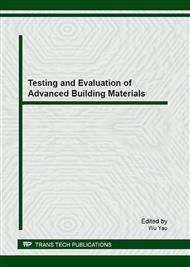p.103
p.108
p.115
p.120
p.124
p.130
p.139
p.145
p.149
Effect of Fly Ash on Resistance to Sulfate Attack of Cement-Based Materials
Abstract:
The resistance to sulfate attack of mortars containing 0%, 20%, and 40% of fly ash cured in 5 wt. % sodium sulfate solution at 20°C was investigated in this paper. Visual appearance, cracking analysis, velocity of ultrasonic wave and length change were applied to evaluate the sulfate resistance of mortars. The phases and microstructure of the reaction products due to sulfate attack were examined by XRD and SEM, and the pore structure of the mortars was analyzed by MIP. The effects of fly ash on the sulfate attack of mortars were analyzed. Results indicated that the addition of fly ash improved the resistance of sulfate attack significantly, this probably contributed to the pozzonlanic reaction of fly ash.
Info:
Periodical:
Pages:
124-129
Citation:
Online since:
January 2013
Authors:
Keywords:
Price:
Сopyright:
© 2013 Trans Tech Publications Ltd. All Rights Reserved
Share:
Citation:


